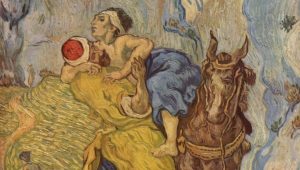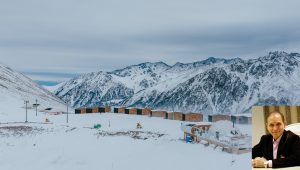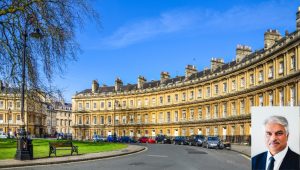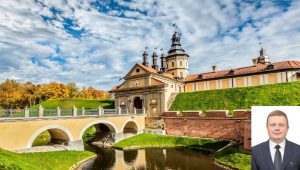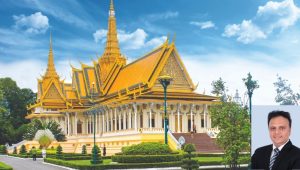A LAND OF RICH CULTURE AND HISTORY
We all know about Tunisia’s wonderful beaches, but do you know about its fascinating culture and wealth of history? In fact, Tunisia is like an open-air museum, with ancient treasures to explore wherever you look. It’s a great choice for combining a beach holiday with sightseeing
By His Excellency Mr. Nabil Ben Khedher, Ambassador of Tunisia to the United Kingdom
No matter whether you prefer a pure beach holiday or wandering around monuments from the Roman times, Tunisia the northernmost African country has it all. It is an oasis of historical sites, beautiful landscapes, picturesque beaches and rich in culture. The country has remained alive in history for thousands of years with many UNESCO World Heritage Sites just waiting to be explored. It’s time to plan your holiday in Tunisia!
6 REASONS WHY TUNISIAN CULTURE APPEALS TO VISITORS:
1. Several UNESCO World Heritage
Sites Tunisia has no less than eight UNESCO World Heritage Sites, which are all well worth visiting. These are: the Amphitheatre of El Jem (1979), Kerkouane, (1985), Dougga (1997), Kairouan (1988), Medina of Sousse (1988), Medina of Tunis (1979), the Site of Carthage (1979) and Ichkeul National Park (1980).
2. Legacy of diverse cultures through the ages
Due to its strategic position,Tunisia has been home to many great civilisations, throughout its 3000- year history. These include: the Berbers (the original inhabitants of Tunisia), Carthaginians, Romans, Vandals, Byzantines, Arabs, Ottomans and Europeans.
3. Discover the great Empire of Carthage
Tunisia was the cradle of the Empire of Carthage, founded in 814 BC and the homeland of Hannibal, the famous hero who challenged Rome. It was also the birthplace of Magon, the first agronomist and winegrower, whose legacy is still in use today in Tunisia’s wine industry..
4. Kairouan: The first capital of the Maghreb
Away from the coast, in a landscape of steppes, Kairouan is a fascinating city still anchored in a distant past. One of Islam’s holy cities, it was the first capital of the Maghreb. Designated a UNESCO World Heritage site, it conceals several marvels: the medina, the venerable Great Mosque, the Aghlabid Basins, the stunning mausoleum of SidiSahbi decorated with ceramic tiles… And of course it is impossible to forget the numerous workshops where the most famous knotted pile carpets in Tunisia are made.
5. Explore Roman sites and see beautiful mosaics
Tunisia thrived under the Romans! They stayed in the country for 6 centuries. Their majestic remains are well preserved, such as the coliseum of El Jem, the third largest in the Roman Empire, the opulent city of Douggaand the brightly coloured mosaics, which are on display in the Bardo Museum
6. Experience the Berber culture and way of life
The indigenousTunisian people, the Berbers, always lived on the edge of the space of those who invaded the country, but lived peacefully alongside them. Still today, they live in the rocky desert in the south east, following the lifestyle and traditions of their ancestors. They are famous for their troglodyte houses, hilltop villages and collective, fortified granaries known as Ksour, which stock their scarce food supply.
SILKY WHITE SANDY BEACHES BLENDED WITH CLEAR TURQUOISE WATERS!
Tunisia has pretty much something for all its guests, especially families. Tunisia is one of the perfect family holiday destination. All the leading operators to Tunisia include family options.
EXPERIENCE RELAXATION WITH THALASSO & SPA CENTRES
Spa facilities are now something of a holiday essential. A wide range of treatments are available and there is plenty of quiet relaxation and luxury pampering.
GOLDEN AGE PAMPERED BY WARM TUNISIAN WINTER SUNSHINE!
Dynamic seniors represent an important niche for Tunisia especially during low & shoulder seasons. They are looking for:
- An affordable winter in the sun while escaping the British cold winters. Winter in Tunisia is mild. 17C is average temperature. Excursions to different places of interest become popular. For some, Tunisia becomes a second home during their long stays.
- Outdoor activities: all hotels in Tunisia are beach front and very close to activity spots such as Golf courses If you’re staying in Hammamet there are 2 fabulous golf courses ( Yasmine & Citrus) about 5 miles away , Green fees are very reasonably priced dotted with comfortable clubhouses. They can play golf all year round.
- Many of them love Nature! There are 17 natural parks and 27 natural reserves which continue to stir the curiosity of visitors among them Ichkeul National Park which has been added to the World Heritage List since 1980. Tunisia is a haven for a large number of migratory birds from Europe and Africa. This makes it as a well-known Birdwatching destination. Also, among the uniqueness of Tunisia is that a very visible landscape contrast from the green mountains of the North to the Sahara Desert compressed in a tiny piece of land called Tunisia
THE TUNISIAN OASIS & SAHARA
The uniqueness about Tunisia’s desert is that visitors rarely have to travel too far to get there. They can take a two day trip excursion, spend an overnight in a desert inn or opt for a longer stay under a bivouac tent or in a camp The Saharan scenery will certainly live up to everyone’s image of a desert landscape! It could be rocky where the incredible Berber villages, which have been carved out of the rocky crags they hang to and strange fortified Ksours granaries built by nomadic tribes to keep their food supply in. Or it could be sandy characterised by the golden and soft sand dunes. There is also bizarre salt lakes as Chotts which are seasonal lakes – dry for most of the year – The most famous one is Chott El Jerid. There are also, three types of Oases, Maritime in the North East of the desert, the Sandy oases planted with palm trees and mountain oases in the North West of the Desert.
A GASTRONOMIC JOURNEY AROUND TUNISIA
Tunisia has a rich cuisine, inspired by the many diverse cultures that have lived over its long history – from the Berbers and Carthaginians to the Romans, the Ottomans to the French. This journey is not only a journey around Tunisia, but also a voyage of discovery, basking into its rich past. The capital of Tunis is a great place to start our gastronomic journey. The ancient medina, with its labyrinth of narrow streets and entrancing souks, is the ideal place to sample one of the bespoken Tunisia’s street food speciality – brik a l’oeuf, egg encased in flaky filo pastry, its runny yolk providing a perfect contrast to the crisp pastry. Wine making in Tunisia dates back some 2000 years to the famous Carthaginian agronomist, Magon, after whom one of the country’s most famous wines is named. There has been a recent resurgence in wine making and you can try delicious local tipples including light rosés, sparkling whites and rich reds – the perfect way to reflect on a busy day’s sightseeing or a lazy day at the beach! Nabeul, close to the popular resort of Hammamet, is famous for its peppers and, therefore, one of Tunisia’s most important culinary delights – harissa – introduced by the Berbers. This Tunisian chilli paste is used to flavour everything from couscous to spicy seafood pasta, and is often served on its own as a condiment or as an appetiser with freshly baked bread with a dash of olive oil. Wherever you choose to visit during your holiday in Tunisia, the local cuisine is sure to be a highlight – as well as an introduction to the rich history of the country






